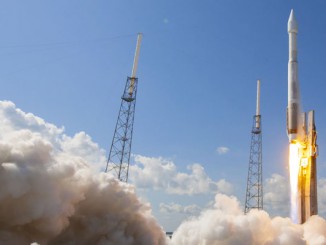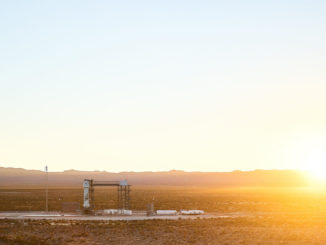
United Launch Alliance recently raised a Delta 4-Heavy rocket, one of four left in the company’s backlog, vertical on its launch pad at Vandenberg Air Force Base in California in preparation for liftoff with a top secret U.S. government spy satellite at the end of April.
The powerful liquid-fueled launcher rolled out of ULA’s Horizontal Integration Facility at Vandenberg for the trek to nearby Space Launch Complex-6, or SLC-6. Riding a 36-wheel, diesel-powered transporter, the Delta 4-Heavy left the hangar Feb. 15 for the trip to the pad, then ULA ground crews raised the rocket vertical on the launch mount Feb. 16, the company said.
The Delta 4-Heavy rocket is the most powerful launcher in ULA’s fleet, capable of hauling nearly 52,000 pounds (nearly 23.6 metric tons) to a low-altitude orbit inclined to fly over Earth’s poles. The classified payload flying on the Delta 4-Heavy rocket in late April is expected to launch into a high-inclination orbit a few hundred miles above Earth.
But the exact orbital parameters are secret, a request from the mission’s customer, the National Reconnaissance Office. The NRO owns the government’s network of optical, radar, and signals intelligence-gathering satellites.
The mission for the next Delta 4-Heavy rocket from Vandenberg is designated NROL-82. It will be the 42nd flight of a Delta 4 rocket since 2002, and the 13th launch of the Delta 4-Heavy configuration, which uses three Delta 4 rocket cores connected together to haul more massive payloads into orbit.
The NROL-82 mission is scheduled to launch at the “end of April,” said Col. David Rickards, director of staff at the 30th Space Wing at Vandenberg, in a presentation March 4 discussing the base’s plans for 2021. NRO and ULA officials have not announced the target launch date, but the mission is expected to be ULA’s first mission of the year after delays in the launch from Cape Canaveral of Boeing’s Starliner crew capsule on an unpiloted test flight.
The Delta 4-Heavy rocket will likely deliver the NRO’s next KH-11 optical reconnaissance satellite to orbit. The KH-11 satellites are about the size of a bus, fitted with large telescopes pointing down at Earth to collect unmatched high-resolution images of strategic locations around the world for analysis by U.S. intelligence agencies.
The KH-11 satellites require the heavy-lifting capability of the Delta 4-Heavy, along with the rocket’s voluminous payload shroud. All of the Delta 4-Heavy missions from Vandenberg have carried KH-11 satellites to space. The exact imaging capabilities of the KH-11 satellites are top secret, and the NRO does not publicly identify the types of spacecraft on each of its launches.

ULA delivered components of the Delta 4-Heavy rocket to Vandenberg from the company’s factory in Alabama last year aboard the “RocketShip” transport vessel. Ground teams assembled the three Delta 4-Heavy rocket boosters, each powered by an Aerojet Rocketdyne RS-68A engine, inside the Horizontal Integration Facility near the SLC-6 launch pad.
Teams at Vandenberg also installed the rocket’s cryogenic second stage, with an Aerojet Rocketdyne RL10 engine, to finish the initial build-up of the 170-foot (52-meter) launch vehicle.
ULA technicians then connected a launch mate unit to the base of the Delta 4-Heavy cores, providing a structural connection for the the rocket. The unit also has 12 pyrotechnic hold-down bolts that fire to release the rocket at liftoff, according to ULA
With the rocket raised vertical on the SLC-6 launch pad overlooking the Pacific Ocean, teams at Vandenberg planned to load super-cold liquid hydrogen and liquid oxygen propellants into the Delta 4-Heavy for a countdown rehearsal. After draining the propellants, ULA plans to hoist the payload for the NROL-82 mission atop the Delta 4-Heavy to complete assembly of the 233-foot-tall (71-meter) rocket.
The Delta 4-Heavy rocket is being retired in favor of ULA’s next-generation Vulcan Centaur launcher family, which will replace the Atlas and Delta rocket fleets. Including the NROL-82 mission, ULA has four Delta 4-Heavy flights scheduled through 2023 — two from Vandenberg and two from Cape Canaveral.
All four remaining Delta 4-Heavy missions will launch spy satellite payloads for the National Reconnaissance Office. Contracts for future launches of large NRO payloads will be awarded in competitions between ULA and SpaceX.
Email the author.
Follow Stephen Clark on Twitter: @StephenClark1.



